

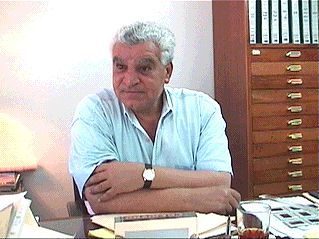
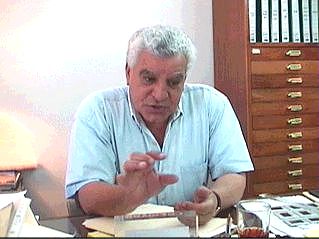
I next met with Dr. Hawass on April 10, 2000 in his office on the Giza Plateau. Here's what we talked about this time:
Guardian: This trip we've been studying the evolution of the
pyramids. One of the things that I've been communicating on the Internet over
the years is how the pyramids developed sequentially, so when people look at the
Great Pyramid they understand that it is the product of this evolution and did
not just completely and miraculously arise out of nowhere. I was very
excited about the recent discoveries within the pyramid at Meidum of relieving
architecture, not just over the antechamber, but also over the descending
passageway. This corbelling above this passageway looks similar to the
design of the Grand Gallery. Can you comment on this discovery?
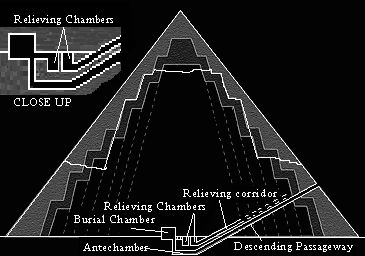
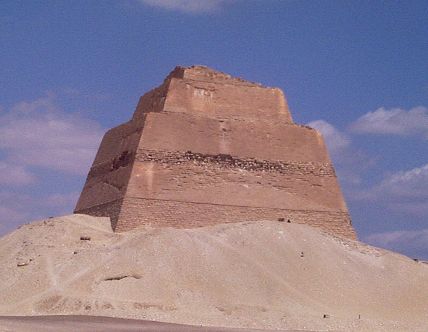
Southwest Corner of the the Meidum Pyramid
Guardian: When the builders at Meidum had gone back and went to convert the step pyramid to a true pyramid they had already encased the steps. Do you believe that the failure to remove this casing before expanding the sides contributed to its collapsed state?
Dr. Hawass: In my opinion the collapse in later times, not during the pharaonic period for one important reason. The ancient Egyptians from the New Kingdom came to this pyramid and they wrote in hieroglyphics talking about the glory of this pyramid. If the pyramid was collapsed they would never write this graffiti. And therefore I believe that as recently as 200 years ago when the Egyptians used to take stones from pyramids to build dams and houses and things like this and they used to bring camels to take stones even to build houses nearby, that's when the collapse happened. There is no evidence that the collapse happened in the pharaonic period.
Guardian: There is evidence at the side south of the Meidum pyramid of a subsidiary pyramid which would make this the first pyramid with a subsidiary pyramid. Do you agree?
Dr. Hawass: If the Meidum pyramid is before the Bent Pyramid then the Meidum pyramid could be the first pyramid with a subsidiary pyramid.
Guardian: In your opinion is the subsidiary pyramid an evolution from the South Tomb at the Step Pyramid complex at Saqqara?
Dr. Hawass: In my opinion the subsidiary pyramids in the south of the pyramid has two functions. One is as a Queen's Pyramid. If you find evidence inside this pyramid it means burial for a Queen. But this pyramid located on the southeast corner of the main pyramid, which we call the satellite pyramid, the function of this pyramid is, in my opinion, it is like a ceremonial way that the ancient Egyptian king used it for changing clothes. He'd go inside this pyramid symbolically, and he leaves his gowns and he leaves his robe and he'll wear his skirt and he'll go out of the pyramid to the court on front of the pyramid and he'd play the Sed Festival to show that he'd finished all the requirements that the tradition of Egypt asked him to do. That he would do the celebration means that he built a tomb for himself and he built temples for the worship of the gods, and he smited the enemies of Egypt, and united the two lands. If he will do that, he will become a god and therefore this pyramid is the place for the celebration symbolically.
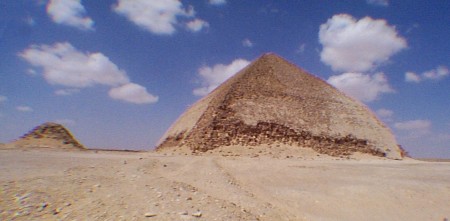
The Bent Pyramid and its satellite Pyramid
Guardian: And is it the same thing for the south tomb in the Djoser complex?
Dr. Hawass: Exactly.
Guardian: So, why do you suspect that he would change clothes there? Is there some evidence of this?
Dr. Hawass: There is some evidence of this like if you look at the funerary temple of any pyramid, especially with Dynasty 5 and 6, which has scenes. All the scenes show three important things. One scene shows the king sitting on the throne wearing his robe and wearing his gown. There is another scene showing the king dancing. And the third scene the king becomes a god. Therefore I believe that the period from sitting on the throne to running, it is this period is the pyramid. And we don't have any evidence that the Heb Sed was celebrated by the ancient Egyptian after 32 years, after 30 years, this is just happened in the Late Period. And this is why, in my opinion, the Heb Sed is a celebration that the king used and the most important evidence that we do have is the Heb Sed scenes that are shown in the south tomb. That is really giving the function of the satellite pyramid to be connected with the Sed Festival.
Guardian: How might this relate to the 1st and 2nd Dynasty kings having seemingly two tombs, one in Abydos and one at Saqqara, and is obviously only able to be buried in one? Is this an analogy or is this different?
Dr. Hawass: It is known now as a fact that the kings of Dynasty 1 do not have two tombs. It is known as a fact that royal tombs of the 1st Dynasty are in Abydos and the tombs at Saqqara they are for the officials who helped the king in his lifetime. And all the tombs of the kings of Dynasty 2 are underneath the funerary temple of Unas, except two tombs of the last two kings of Dynasty 2, which is Peribsen and Khasekhemwy that are buried at Saqqara. It is known from recent excavations at Abydos now that the last king of Dynasty 0 is Narmer and the first king of Dynasty 1 is Mena. And the Egyptians knew writing 200 years before 3000 BC. Djoser is not the second king of Dynasty 3, he is the first king of Dynasty 3 based on that his name was found written in the tomb of his father, Khasekhemwy. And that's what shows that excavations reconstruct history we can understand from what's happening now lots of ideas about the pyramid age
Guardian: So the pyramid that you recently discovered between the Queen's pyramids and the Great Pyramid, that would be the satellite pyramid you believe that would be the satellite pyramid of the Great Pyramid?
Dr. Hawass: That is a T-shaped satellite pyramid. There are two types in the Old Kingdom. One shape is a T-letter shape, the burial chamber and the entrance. The other style is where the satellite pyramid is the exact shape of the main pyramid, but smaller. It's a model of the main pyramid in the interior, like the trial passage to the east of the Great Pyramid is a model for the Great Pyramid and therefore the satellite Pyramid of Khufu that I found is a satellite pyramid or a ritual pyramid as we call it sometimes, or a cult pyramid. These are the three names that we have for this type of pyramid.
Guardian: Do you believe that Sneferu was buried in the Northern Pyramid, the Red Pyramid?
Dr. Hawass: We don't know but it seems that the Bent Pyramid because its mysterious and not excavated or been fully investigated yet, and this discovery of the relieving chambers at Meidum could say that maybe Sneferu at the end of his reign because he changed the Meidum Pyramid to be a true pyramid and he wanted to hide his burial of his body and therefore he built this mysterious passages inside the Meidum pyramid to deceive thieves to be buried inside a resting place that no one would know where it is.
Guardian: OK, so if you don't believe that the Meidum pyramid collapsed in antiquity, which I don't either, what do you ascribe the change in angle to?
Dr. Hawass: It's an architectural style. Clearly if the architect had continued to build this pyramid with the same angle that he started it would be a very large, huge pyramid that therefore for him to avoid that is to change the angle and still he changed the angle did not really change anything of the architecture of the pyramid shape he still having it and this pyramid is one of the most important pyramids that we can study about the casing, it's a pyramid that needs a lot of research and needs lots of work.
Guardian: I've read theories from people that believe that the angle change was due to structural cracking and shifting within the passageways and chambers, even during the time it was being built. I don't know that there's any real evidence to prove that.
Dr. Hawass: We don't really have any evidence of this. But most Egyptologists now that study the pyramids believe what I've already mentioned, this is simple, it's not really complicated this is very simple, that's the reason that Sneferu changed the angle. And Sneferu now has 4 pyramids, which is Seila as a palace, after that he built the Meidum pyramid as a Step Pyramid, he went and did not finish the Bent Pyramid , then he built the Red Pyramid when he had time. Because building in ancient Egypt depends on the reign of the king, and the power of the king. Ramesses II built lots of temples and statues everywhere because he ruled for 66 years and therefore I believe, and all of believe that Sneferu ruled for 46 years and therefore the 46 years were enough for him to be one of the greatest builders in the Old Kingdom.
Guardian: What do you then believe the wooden timbers, sometimes called scaffolding are inside the Bent Pyramid?
Dr. Hawass: You know it seems to me that this could be a way of hiding the burial chamber and they could not really cut it after that and this shows that we need really to do more research inside this pyramid.
Guardian: So, you view these timbers as evidence that the pyramid was not finished?
Dr. Hawass: It's evidence of putting the burial chamber somewhere and they were trying to take this scaffolding out and they did not. The existence of the scaffolding could be encouraging us to do more research inside the pyramid.
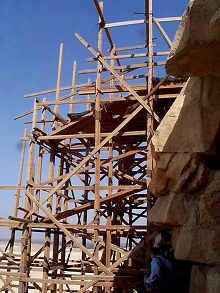
Guardian: During this visit there is finally modern scaffolding leading to the northern entrance. You are finally doing work in there now?
Dr. Hawass: We are thinking to do that.
Guardian: In entering I noticed the beginning of an effort to clear the interior.
Dr. Hawass: We did a little bit. But with this scaffolding now so we can continue the research. And I thought to do something, but next week I'll be going to Bahriya.
Guardian: Let's move on to the so-called Osiris Shaft. Why do you call this the Osiris Tomb? Were there any such inscriptions in there?
Dr. Hawass: This shaft, everyone knows about it, and people have talked about and there are lots of rumors about it. I found out that the water table that was preventing it from being again explored became low a little bit and this is when I started my excavation. I found that this shaft consists of three levels. The first level goes down maybe 12 feet. And after that the second level we excavate3d and we found out that it has 6 rooms cut in it. Inside the 6 rooms there are 2 large sarcophagi made of granite. And inside the area there is much pottery and bones. I dated this level to 26th Dynasty, 500 BC. based on the pottery style and that this second shaft was cut later. Then after that when you go to the third level that was interesting. It was very hard work because we drained the water in the shaft 90 feet down. We had to take the dirt from down there up 90 feet. It was like an adventure and a big operation that never happened before in any place in Egypt or outside Egypt. But the result was very interesting. When we finished the excavations this is what I found:
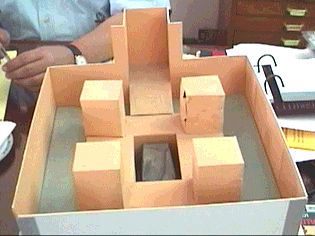 The
remains of 4 pillars. Inside the 4 pillars a big, large granite sarcophagus
surrounded by water. Two important discoveries happened here. The first one is a
statement written by Herodotus, the "Father of History". When he came
to Egypt in the middle of the 5th Century BC, he wrote stories about Giza.
One of the most interesting stories that laymen, scholars, and Egyptologists
talk about was that he said that he saw that Khufu, or Cheops, was buried in a
large sarcophagus and there is a big lake near the Great Pyramid. Everyone said
that if Herodotus saw this, where is this water, where is this lake? This is
exactly what he saw. Because he would never go as an old man down 90 feet. The
people, the guides at the plateau who will say anything, they used to swim in
this place. Because today, before I excavated that, they used to swim and drink
from this water. And therefore, since ancient times they did the same. In the
past, when they met Herodotus they told him that Khufu was buried here and there
is a big lake near the Great Pyramid. This is away from the pyramid about 600
feet. Even today when you describe it, there is water near the Great
Pyramid, you will not say there is water near the second pyramid , what's
famous here is the first pyramid. That's exactly what they told Herodotus when
he came here in the middle of the 5th century BC .
The
remains of 4 pillars. Inside the 4 pillars a big, large granite sarcophagus
surrounded by water. Two important discoveries happened here. The first one is a
statement written by Herodotus, the "Father of History". When he came
to Egypt in the middle of the 5th Century BC, he wrote stories about Giza.
One of the most interesting stories that laymen, scholars, and Egyptologists
talk about was that he said that he saw that Khufu, or Cheops, was buried in a
large sarcophagus and there is a big lake near the Great Pyramid. Everyone said
that if Herodotus saw this, where is this water, where is this lake? This is
exactly what he saw. Because he would never go as an old man down 90 feet. The
people, the guides at the plateau who will say anything, they used to swim in
this place. Because today, before I excavated that, they used to swim and drink
from this water. And therefore, since ancient times they did the same. In the
past, when they met Herodotus they told him that Khufu was buried here and there
is a big lake near the Great Pyramid. This is away from the pyramid about 600
feet. Even today when you describe it, there is water near the Great
Pyramid, you will not say there is water near the second pyramid , what's
famous here is the first pyramid. That's exactly what they told Herodotus when
he came here in the middle of the 5th century BC .
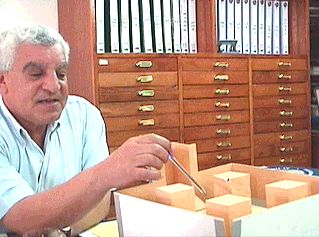 Now,
the second important thing is that the Giza Plateau is known in the New Kingdom
by the word "pr osr nb rstw", it's a hieroglyphic inscription.
"Pr" means, "place", or "house".
"osr" means "Osiris". Together this means the "place of
Osiris". Nb means "Lord". "rstw" means
"cemetery", but literally means "the underground tunnel".
The Giza plateau was called in the New Kingdom by the name, "House of
Osiris, Lord of the Underground Tunnels". And look here (see picture
at right) there is evidence at the beginning before these two pillars of the
hieroglyphic sign "Pr" which means "place". Then this is the
place, symbolically of Osiris, who was buried here, controlling the underground
tunnels at the Giza Plateau. And based on the size of the sarcophagus and the
style of the pottery that has been found inside the shaft I dated this to 1550
BC., the New Kingdom. What's happened is that people knew about this because
this symbolically is like the Osirion at Abydos exactly the same structure of
the pillars as the Osirion at Abydos. This is the Osirion of Giza. Then people
looked at these tunnels when they came in the Late Period and they cut a tunnel
on the west wall of this shaft, and this tunnels goes about 12 feet toward the
Great Pyramid, then it becomes very narrow. We'll need to send a fiber-optic
camera to see beyond this. But this exactly is misunderstood by people who think
that the Osiris tunnels go to the Great Pyramid. But, symbolically it's Osiris
whose buried here resting and controlling it and he is surrounded by this water
because Osiris, for vegetation, the King of the guard of the Afterlife is always
surrounded by water.
Now,
the second important thing is that the Giza Plateau is known in the New Kingdom
by the word "pr osr nb rstw", it's a hieroglyphic inscription.
"Pr" means, "place", or "house".
"osr" means "Osiris". Together this means the "place of
Osiris". Nb means "Lord". "rstw" means
"cemetery", but literally means "the underground tunnel".
The Giza plateau was called in the New Kingdom by the name, "House of
Osiris, Lord of the Underground Tunnels". And look here (see picture
at right) there is evidence at the beginning before these two pillars of the
hieroglyphic sign "Pr" which means "place". Then this is the
place, symbolically of Osiris, who was buried here, controlling the underground
tunnels at the Giza Plateau. And based on the size of the sarcophagus and the
style of the pottery that has been found inside the shaft I dated this to 1550
BC., the New Kingdom. What's happened is that people knew about this because
this symbolically is like the Osirion at Abydos exactly the same structure of
the pillars as the Osirion at Abydos. This is the Osirion of Giza. Then people
looked at these tunnels when they came in the Late Period and they cut a tunnel
on the west wall of this shaft, and this tunnels goes about 12 feet toward the
Great Pyramid, then it becomes very narrow. We'll need to send a fiber-optic
camera to see beyond this. But this exactly is misunderstood by people who think
that the Osiris tunnels go to the Great Pyramid. But, symbolically it's Osiris
whose buried here resting and controlling it and he is surrounded by this water
because Osiris, for vegetation, the King of the guard of the Afterlife is always
surrounded by water.
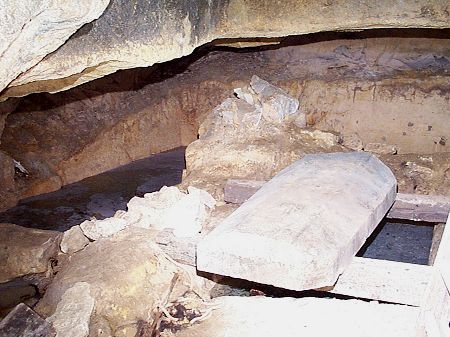
Another look at third level of the Osiris Shaft
Guardian: But weren't bones found here at this level?
Dr. Hawass: Because they used this in the Late Period also for burials.
Guardian: So then you you believe this third level to be originally from the New Kingdom and then later used for burial in the Late Period??
Dr. Hawass: Yes.
Guardian: Is there plans for further excavation in there?
Dr. Hawass: I will go there next week for a month starting the excavation there.
Guardian: And after that, what will you be doing next?
Guardian: And how about the excavation at the south side of the Menkaure Pyramid?
Dr. Hawass: We will also continue the work on this.
Dr. Hawass: No. I do not really find the expertise to do it right. I am waiting for some proposals to tell me how they can do it because you know because we do not want this German to work there.
Guardian: So right now there are no further plans to explore this?
Guardian: You're accepting proposals?
Dr. Hawass: But they did not come yet with a proposal. We are still waiting for more information.
Guardian: When you do that you'll be exploring the northern shaft then?
Dr. Hawass: A pyramid like this, why do you open it to the public? Why do you ruin it? We'll keep it for the future. Because this pyramid is unique. If you need to see a pyramid text, go to the Teti pyramid, but the Unas pyramid is a masterpiece, and therefore we are restoring it to close it.
Guardian: Currently the pyramid of Khafre is closed. When will this restoration be finished and the pyramid reopened?
Dr. Hawass: We will open the Khafre pyramid soon and close the third pyramid. As you know, this is part of a rotation system. Maybe this will be within 2 or 3 months, we'll open the second pyramid.
Guardian: I thank you for taking the time to meet with me each year. I always enjoy these discussion very much.
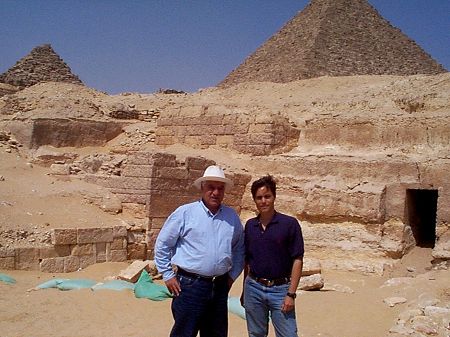
Dr. Hawass and Andrew south of the Pyramid of Menkaure
near the area of the ongoing tomb excavations
|
OTHER SPOTLIGHT INTERVIEWS |
Return to
The Plateau - Official Website of Dr. Zahi Hawass
Return to
 RETURN TO
Guardian's Egypt Main Gate
RETURN TO
Guardian's Egypt Main Gate
Guardian's CyberJourney
To Egypt
Copyright © 2000 Andrew Bayuk
All Rights Reserved